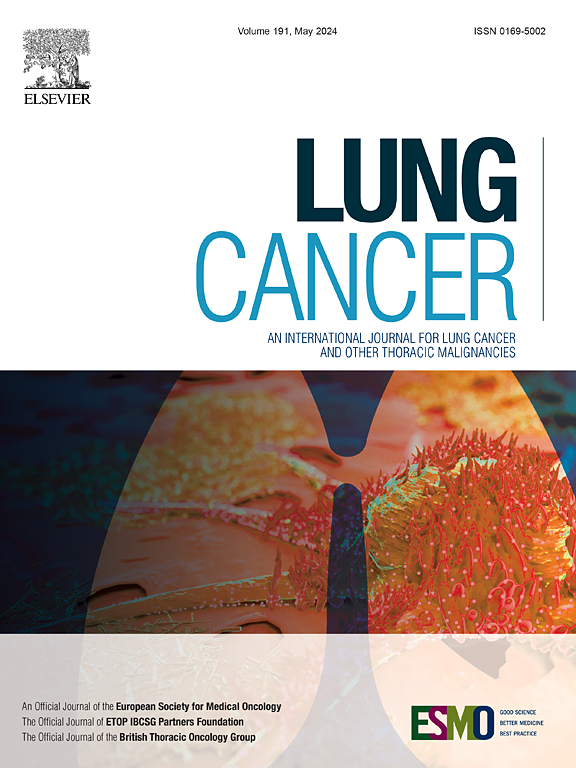Prevalence of osimertinib-induced cardiotoxicity in non-small cell lung cancer patients: a systematic review and meta-analysis
IF 4.4
2区 医学
Q1 ONCOLOGY
引用次数: 0
Abstract
Objective
Osimertinib, a third-generation Epidermal Growth Factor Receptor (EGFR) Tyrosine Kinase Inhibitor (TKI), is the standard of care for patients with EGFR-mutated Non-Small Cell Lung Cancer (NSCLC). While clinically effective, concerns have emerged regarding its potential cardiotoxicity. This study aims to systematically evaluate the prevalence and types of cardiotoxicity associated with Osimertinib.
Methods
A systematic review and meta-analysis were performed in accordance with PRISMA guidelines. Literature searches of PubMed and ClinicalTrials.gov were conducted for studies published between October 2014 and October 2024. Data from 68 studies encompassing 14,050 patients were analyzed using the metafor package in R Studio (version 4.4.1). A generalized linear mixed model with logit transformation was used to estimate pooled prevalence. Heterogeneity was assessed via I2 statistics, and publication bias was evaluated using Egger’s and Begg’s tests.
Results
The overall pooled prevalence of Osimertinib-induced cardiotoxicity was 4.00 % (95 % CI: 2.9–5.48; I2 = 76.9 %). QT prolongation was the most commonly reported event (6.03 %), followed by atrial fibrillation (1.50 %) and cardiac failure (1.21 %). Subgroup analysis showed higher prevalence in randomized controlled trials (4.98 %) versus observational studies (0.78 %), and in combination therapies (4.89 %) versus monotherapy (3.64 %). Regional variation was noted, with the highest prevalence in North America (5.56 %). Egger’s test indicated significant publication bias (p < 0.0001) for several cardiotoxic outcomes.
Conclusion
Osimertinib is associated with a modest but clinically significant risk of cardiotoxicity, particularly QT prolongation. These findings support the need for routine cardiac monitoring in high-risk patients and emphasize the importance of standardized cardiotoxicity reporting in future trials to enhance the safety profile of Osimertinib in NSCLC treatment.

非小细胞肺癌患者中奥西替尼引起的心脏毒性的患病率:一项系统回顾和荟萃分析
奥西替尼是第三代表皮生长因子受体(EGFR)酪氨酸激酶抑制剂(TKI),是EGFR突变的非小细胞肺癌(NSCLC)患者的标准治疗方案。虽然临床有效,但人们担心其潜在的心脏毒性。本研究旨在系统评估与奥西替尼相关的心脏毒性的患病率和类型。方法按照PRISMA指南进行系统评价和meta分析。对2014年10月至2024年10月间发表的研究进行了PubMed和ClinicalTrials.gov的文献检索。使用R Studio(4.4.1版)中的meta包分析了来自68项研究的14,050名患者的数据。采用logit变换的广义线性混合模型估计混合患病率。异质性采用I2统计量评估,发表偏倚采用Egger’s和Begg’s检验评估。结果奥西替尼引起的心脏毒性的总总发生率为4.00% (95% CI: 2.9-5.48;i2 = 76.9%)。QT间期延长是最常见的事件(6.03%),其次是房颤(1.50%)和心力衰竭(1.21%)。亚组分析显示,随机对照试验的患病率(4.98%)高于观察性研究(0.78%),联合治疗(4.89%)高于单药治疗(3.64%)。注意到区域差异,北美的患病率最高(5.56%)。Egger’s检验显示显著的发表偏倚(p <;0.0001)。结论:奥西替尼与中度但临床显著的心脏毒性风险相关,尤其是QT间期延长。这些发现支持了对高危患者进行常规心脏监测的必要性,并强调了在未来试验中标准化心脏毒性报告的重要性,以提高奥西替尼在非小细胞肺癌治疗中的安全性。
本文章由计算机程序翻译,如有差异,请以英文原文为准。
求助全文
约1分钟内获得全文
求助全文
来源期刊

Lung Cancer
医学-呼吸系统
CiteScore
9.40
自引率
3.80%
发文量
407
审稿时长
25 days
期刊介绍:
Lung Cancer is an international publication covering the clinical, translational and basic science of malignancies of the lung and chest region.Original research articles, early reports, review articles, editorials and correspondence covering the prevention, epidemiology and etiology, basic biology, pathology, clinical assessment, surgery, chemotherapy, radiotherapy, combined treatment modalities, other treatment modalities and outcomes of lung cancer are welcome.
 求助内容:
求助内容: 应助结果提醒方式:
应助结果提醒方式:


